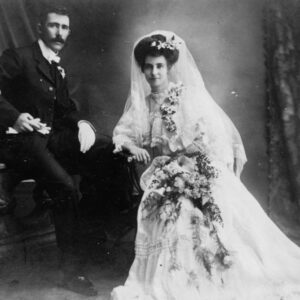EBSTEIN: How and Why We ‘Couple’ in 2024

Thirty-six years ago when I married, I did my makeup and hair. Our chuppah (Jewish wedding canopy) was simple. The food was solid. The music was ample but allowed us to retain our hearing.
Last week, my son got married. My daughters and I had professionals do our faces and hair. The finished product had my husband wondering where I went, but I assured him the cameras would love me more. The food was epicurean quality, and the excellent band was a full seven pieces, which meant loud. I became my mother, asking if we could take a few instruments away.
My son’s wedding led me to do a deep dive into the state of coupling in 2024 — “coupling” because it’s no longer as simple as marriage. Different times call for different models. Here is what I learned.
Number one: We’re back. The marriage rate in the United States has returned to pre-pandemic levels. The Census Bureau reports that for every 1,000 unmarried adults, 34 tied the knot in 2022, an increase from 30 in 2020. Also, the divorce rates are at record lows. For every 1,000 marriages, 13.8 ended in divorce, compared to 14.9 in 2019.
Number two: The biggest factor for getting married is not love, cited only 36 percent of the time. Today, newlyweds identify companionship (39 percent) and financial security (42 percent) as their top factors. Also, Americans are not marrying “young” anymore. Pew Research reports a nearly two-thirds drop to 22 percent in married people by age 25.
We have clearly left the world of Ozzie and Harriet. Once upon a time, marriage was considered the start of adult life — get married, set up a house and have kids. We are definitely having fewer kids. Today, many view their first adult steps as “building a career” and “achieving financial stability.” This might also help explain why the percentage of those who have never been married doubled from 15 percent in 1960 to 31 percent in 2020. If financial security is paramount, other choices become less attractive.
Number three: There is a rising new alternative to both marriage and cohabitation, and it’s called “Living apart together” (LAT). It’s estimated that about 10 percent of adults in Western Europe, the United States, Canada, New Zealand and Australia live apart from their romantic partners. Guesstimates are that the United Kingdom is significantly higher.
LAT partners explain that they are romantically committed while honoring their individuality and autonomy. The photographer at my son’s wedding lives in N.Y. and is marrying a vintner based in California. They anticipate living apart for quite some time, but she said, “We’ll figure it out.” She is not committed to LAT, but careers can alter choices.
Marriages where children from a previous marriage still live with a parent can influence the LAT decision by offering less conflict. The LAT lifestyle is also attractive to same-sex couples, especially some gay men who want to maintain privacy from their unaccepting families.
Curiously, the median age for the first-time marriage of gay men is 35, while for heterosexual men, it is 30.5. Among women, gay or hetero, there is no difference, with their median age being 28. What do we make of that?
Number four: “Gray divorce” is prominent. More than one-third of people who divorce in the United States are older than 50. The reasons are varied, but the gray demographic has a higher percentage of remarried couples, and remarried couples have higher divorce rates. Also affecting the higher incidence is the reduced social stigma of being divorced and the anticipation of living longer. People don’t want to suffer through unsatisfying marriages when the horizon feels long.
Given all these trends, what can we say to newlyweds who hope to build a long, lasting life together? Marriage is a different proposition today. Autonomy, equality and pressing financial realities have created a new gestalt. While “Ozzie and Harriet” may no longer work, the basic principles of listening, compromise and respect still do. The more things change, the more they stay the same.
This explains why the words cited under my son’s chuppah of the renowned Chabad leader Rabbi Menachem Schneerson, who passed in 1994, resonate so deeply. Rabbi Schneerson counseled, “Love is not the overwhelming, blinding emotion we find in the world of fiction. It is the small, everyday acts of being together that make love flourish.”
My rephrasing this sentiment goes like this: Acts that seem as small as pebbles can feel like boulders. Be attentive.



